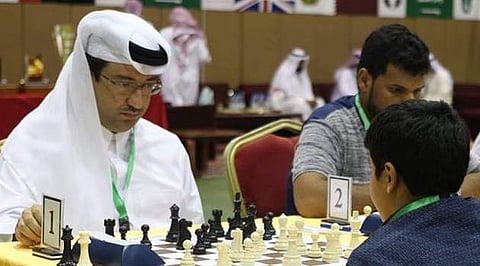

When and how did the game the Arabs adopted as their own become 'haram' (forbidden) for practitioners of the Islamic faith?
In the wake of Indian cricketer Mohammad Kaif being trolled on Facebook for posting a picture of him playing 'anti-Islamic' chess with his son, it is interesting to study the dichotomous relationship between the religion and the game.
The double-player game of strategy and single-minded focus, a primitive version of which is believed to have been played in Eastern India in the Gupta Empire (c. 280–550), was introduced to Persia and Central Asia around 600 AD.
Although it wasn't their own invention, Persians embraced the game played on a checker board. All early Persian references to chess use the term 'chatrang' or 'shatranj', from the Sanskrit 'chaturanga' (meaning, in four parts), which describes the four components of an early Indian army: infantry, cavalry, elephants and chariots.
Seventh century Muslims who conquered Persia ensured the widespread reach of the game to all Islamic lands. A Saidy and N Lessing in their anthology 'The World of Chess', stated that the conquest of Persia by Islam was the most important development in the history of chess.
Persian nomenclature was almost unchangingly adopted into Arabic. Baizag (pawn), fil (bishop), firzan (queen) and rukhkh (rook) are the Arabized forms of the Persian payadah, phil, firzin and rukh. Shah (king) remained the same. Only asp, Persian for horse, was given an Arab translated name, faras (knight) and firzan was later changed to vizir.
Due to the prohibition of human-likeness in Islam, the abstract Arab chess-pieces, unlike the realistic-naturalistic Persian-Indian models, had no resemblance to images. The Muslims created new non-representational chess-pieces.
The Arabs have also been credited for dividing the game into three parts, as we know it today: opening, middle and end games. C Alexander in his 'A Book of Chess', says that the Arabs not only invented the World Chess Championship but also the highest title awarded to a chess player - Grandmaster.
Even the Arab rulers or caliphs mastered enough skill to become experts at chess. Legend has it that Caliph Harun al-Rashid from the 'Arabian Nights', a chess patron and player, was once asked, “What is Chess?”, to which he replied, “What is life?”
To ban or not to ban
Chess, although a game primarily relying on superior skill, is viewed by some religious clerics in the same light as gambling.
Islamic countries are known for their changing stance on the game.
Playing chess in public was declared forbidden after the 1979 Islamic revolution by senior clerics because it was associated with gambling. During the 90s, the Taliban prohibited chess in Afghanistan.
But in 1988, Iran’s then supreme leader, Ayatollah Ruhollah Khomeini, lifted the ban and permitted the playing of the chess, as long as gambling was not involved in it. Today there is a confederation in Iran for the game.
In January 2016, Saudi's Sheikh Abdulaziz al-Sheikh, while answering a question on a television show, likened chess to a vice. The Guardian quoted him as saying chess was “included under gambling” and was “a waste of time and money and a cause for hatred and enmity between players”.
Religious authorities often refer to the verse in the Qur’an which calls out against vices like “intoxicants, gambling, idolatry and divination”.
Islamic scholars continue to remain divided over their interpretation of the verse.
Recognising the game's mathematical benefits, educational institutions are increasingly taking it up.
Eight times world memory champion Dominic O’Brien's comment following the Sheikh's reply is useful to remember: "If chess is haram, so must be the use of imagination, logical thinking, strategic planning and memory."
Too few grandmasters hailing from Islamic countries
A look at the current top 10 world grandmasters (male players) prompts one to ask: Why aren't players from Islamic countries making it big in the world of chess?
Shakhriyar Mamedyarov (FIDE rating: 2800, as on July 2017), currently rated sixth in the world, is perhaps the only Muslim grandmaster we know of, today. The two-time World Junior Champion (the only male player to have won it more than once), hails from Azerbaijan. India's own Grandmaster Vishwanathan Anand is ranked at ninth place.
The absence of a prominent name among female Muslim chess players in international circuits tells a whole different story. Tehran's Mitra Hejazipour, a woman grandmaster (FIDE rating: 2351) who won the 2015 Asian continental women’s championship, is better-known than her contemporaries, with a rating of 120 among active female chess players across the globe.
In October last year, Iran's imposition of its Islamic dress code on women players from across the world at the Women's World Chess Championship 2017 in Tehran, drew a severe backlash, particularly from players representing Western countries.